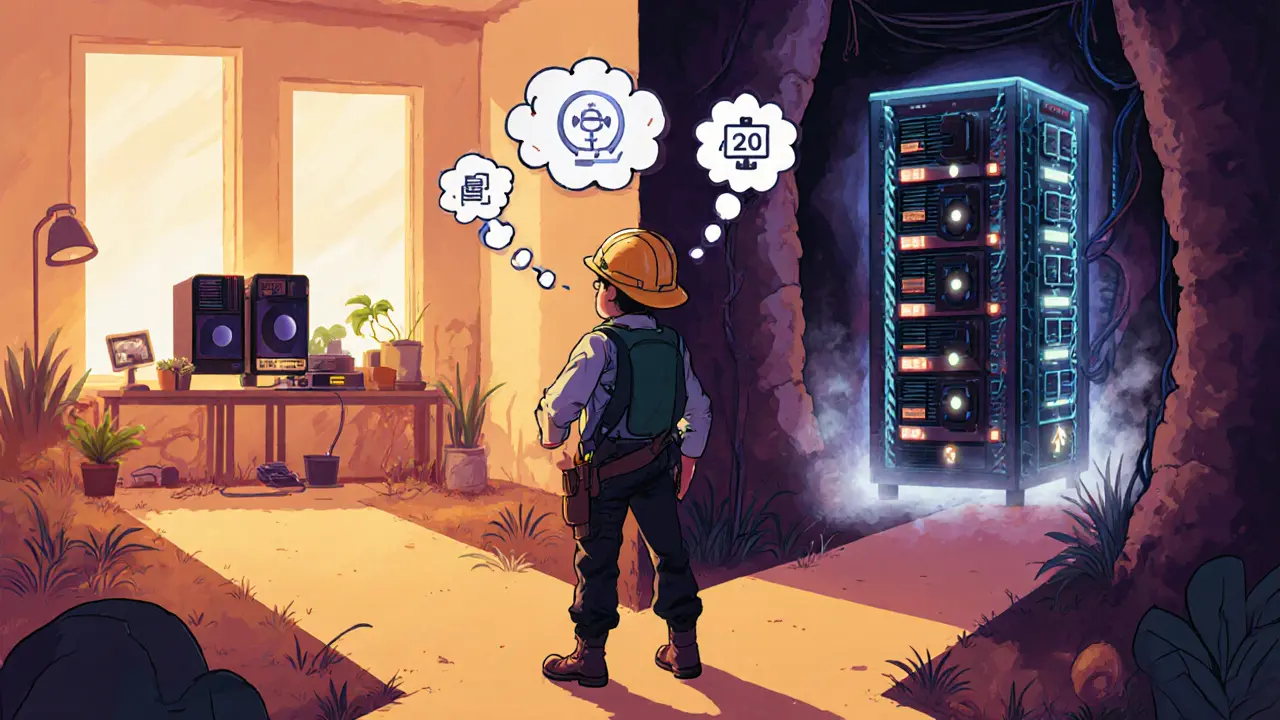GPU vs ASIC Mining Profitability Calculator
GPU Mining
ASIC Mining
When you hear the words GPU mining is the practice of using graphics cards to solve crypto‑hash puzzles and ASIC mining is the use of purpose‑built chips that only run a single algorithm, the debate instantly sparks: which setup gives you more profit, less hassle, or longer usefulness? In 2025 the conversation has matured - it’s not just about raw speed, but about power bills, flexibility, and what you can do with the hardware when mining slows down.
Quick takeaways
- ASICs deliver massively higher hashrate (TH/s) with lower energy per hash, making them the clear winner for Bitcoin‑type, high‑difficulty chains.
- GPUs stay relevant for memory‑intensive and ASIC‑resistant coins like Ethereum Classic, Ravencoin, or emerging PoW projects.
- Up‑front cost: a single ASIC can cost $3,000‑$10,000, while a decent GPU rig (4×RTX4090) is usually under $5,000.
- Flexibility: GPUs can flip between algorithms in minutes; ASICs are locked to one coin.
- Resale value: GPUs can be sold to gamers or repurposed for AI, while ASICs often become obsolete quickly.
How the two technologies work
GPU mining leverages the parallel processing cores of graphics cards originally built for rendering 3D scenes. Those cores excel at handling the thousands of independent hash calculations required by algorithms like Ethash or KawPoW.
In contrast, ASIC mining uses chips that are etched to perform one specific cryptographic function. By eliminating all the extra circuitry needed for general‑purpose tasks, ASICs can crank out hashes at speeds measured in terahashes per second (TH/s) while sipping far less power.
Performance and efficiency showdown
Here’s a snapshot of the numbers you’ll see on the market today:
| Metric | GPU (RTX4090) | ASIC (Antminer S21 Hydro) |
|---|---|---|
| Hashrate | ~120MH/s (Ethash) | 335TH/s (SHA‑256) |
| Power consumption | 450W | 5,360W |
| Hash per watt | 0.27MH/W | 62.5GH/W |
| Initial price | ≈$1,800 | ≈$8,900 |
| Algorithm lock | Flexible (multiple) | Fixed (SHA‑256) |
| Resale market | Strong (gaming/AI) | Weak, often scrap |
Notice the staggering difference in hashrate. While a single RTX4090 can’t compete with an Antminer on raw speed, its efficiency per watt is respectable for the algorithms it targets. ASICs dominate the efficiency race for fixed‑algorithm coins, which translates directly into lower mining profitability when electricity is cheap.

Cost, ROI, and electricity considerations
Profitability hinges on three variables: hardware cost, electricity price, and network difficulty. In regions where electricity costs under $0.05/kWh, an Antminer S21 Hydro can achieve a break‑even in 6‑8months on Bitcoin, assuming stable difficulty and a modest BTC price.
GPU rigs, however, require less specialized infrastructure. A four‑card RTX4090 setup (≈$7,200 total) may need only a standard 1200W PSU and basic air cooling. If you mine a mix of ETH‑compatible and ASIC‑resistant coins, you could see a ROI in 12‑14months even at $0.12/kWh.
Flexibility and real‑world use cases
Flexibility is the biggest selling point for GPU mining. A miner can switch from Ethereum Classic to Ravencoin to a new PoW token overnight simply by changing the mining software and a few config lines. This agility protects you from sudden drops in a single coin’s profitability.
ASIC miners lock you into one chain. The Bitmain Antminer S21 Hydro produces 335TH/s on SHA‑256 and is designed for Bitcoin mining. If Bitcoin’s price crashes or the network implements a hard fork that renders the chip incompatible, your hardware sits idle.
Beyond mining, GPUs have a second life. Once mining winds down, an RTX4090 can be sold to a gamer for $1,500‑$2,000 or repurposed for AI model inference-an added safety net for hobbyists.
Setup, noise, and cooling requirements
GPU mining can be launched in a typical home office. You’ll need decent case fans and maybe a small aftermarket cooler. Noise levels hover around 60dB - comparable to a busy kitchen.
ASIC rigs are industrial. The Antminer S21 Hydro runs at ~85dB and generates enough heat to raise room temperature by 15°F. Most operators place them in dedicated racks with forced‑air or liquid cooling, and the power draw often demands a 3‑phase supply.
Future outlook and emerging trends
Even with the Ethereum merge, Ethereum Classic and other Ethash‑based chains keep GPU mining alive. New ASIC‑resistant projects (e.g., RandomX‑based coins) are also gaining traction, ensuring a niche where GPUs stay profitable.
On the ASIC front, manufacturers are squeezing out extra efficiency. The 2025 Antminer D9 for Dash delivers 1.7TH/s at 2,836W, a ~15% improvement over its 2023 predecessor. Unless you have access to ultra‑low electricity, ASICs will remain the go‑to for Bitcoin‑scale hashing.
In a nutshell, the right choice depends on three questions you should ask yourself today:
- Do you have cheap, reliable electricity? If yes, ASICs likely give you the fastest ROI on Bitcoin or Scrypt coins.
- Do you need to hop between coins or keep hardware useful after mining? Then GPUs win.
- Can you afford the infrastructure (cooling, power, noise mitigation)? ASICs demand more than a typical home setup.
Answering these will point you toward the hardware that matches your budget, risk tolerance, and long‑term plans.

Frequently Asked Questions
Which is more profitable in 2025, GPU or ASIC mining?
Profitability depends on electricity cost and the coin you target. ASICs usually beat GPUs on Bitcoin and other high‑difficulty SHA‑256 chains if power is cheap (< $0.06/kWh). For ASIC‑resistant coins like Ethereum Classic, GPUs often generate higher net profit because they can switch to the most lucrative algorithm.
Can I use a GPU rig for anything after I stop mining?
Yes. GPUs such as the RTX4090 are in demand for gaming, 3D rendering, and AI workloads. You can resell the cards or repurpose them for machine‑learning tasks, which helps recover part of the initial investment.
Do ASIC miners become obsolete faster than GPUs?
Generally, yes. ASICs are tied to a single algorithm, so a network upgrade or shift to proof‑of‑stake can render them useless. GPUs retain value because they support a wide range of software beyond crypto.
What kind of cooling do I need for an Antminer?
Most 2025 ASICs ship with built‑in high‑speed fans. For sustained operation you’ll want dedicated rack ventilation, possibly an industrial air‑conditioning unit, or a liquid‑cooling loop if you plan to stack multiple units.
Is the upfront cost of an ASIC worth the long‑term gains?
If you can secure low‑cost electricity and have space for a noisy, power‑hungry setup, the high hash rate of ASICs typically yields a quicker break‑even than a GPU rig. Otherwise, the flexibility and lower initial spend of GPUs may be a better fit.


Comments
Parker Dixon
Great rundown! 🚀 The GPU vs ASIC debate really hinges on electricity costs, hardware flexibility, and future resale value. If you have cheap power, ASICs can crush the ROI numbers, but GPUs give you that safety net of being repurposable for gaming or AI work later on. Also, the noise and cooling requirements are a huge factor – not everyone wants a mini industrial fan blowing in their bedroom. I love that you highlighted the resale market; many miners forget that you can still get decent cash for a good RTX‑4090. Overall, this piece is a solid guide for anyone weighing up their next mining investment. 😊
December 27, 2024 AT 23:33
Stefano Benny
Honestly, the whole ASIC‑vs‑GPU hype is just a marketing echo chamber. 🔧 When you strip away the buzzwords, ASICs are just a single‑purpose brute force, lacking the adaptability needed for the ever‑shifting PoW landscape. In a high‑voltage grid, the marginal cost of that extra terahash per watt is negligible compared to the opportunity cost of a locked‑in algorithm. GPUs, on the other hand, provide a modular hash‑compute substrate that can be re‑tuned on the fly – a crucial advantage in a volatility‑driven market. So, if you’re not already entrenched in low‑cost electricity regimes, the ROI calculus tilts sharply toward GPU rigs. 💡
December 28, 2024 AT 13:26
Bobby Ferew
Well, I guess it's all about the *feel* of the hardware, right? The ASICs sound impressive with their terahash numbers, but they also feel a bit… cold, like a soulless machine that only knows one song. GPUs, by contrast, have that warm glow of versatility – you can flip from Ethereum Classic to some random PoW meme coin while sipping coffee. Still, the power bills can haunt you like a lingering ghost, especially if you’re not in a cheap‑electricity zone. In the end, it's just another trade‑off that keeps the crypto night‑owls awake.
December 29, 2024 AT 03:19
celester Johnson
From a philosophical standpoint, the dichotomy between ASICs and GPUs mirrors the classic conflict between determinism and free will. An ASIC is deterministic – it exists solely to fulfill a pre‑ordained function, mirroring a fate‑bound existence. A GPU, however, embodies potentiality; it can adapt, learn, and be redeployed, echoing the human capacity for self‑reinvention. This is not merely a hardware debate but an ontological one: do we choose the rigid path of efficiency, or do we embrace the fluidity of adaptability? The answer, perhaps, lies not in the hashes per second, but in the values we assign to flexibility versus raw power.
December 29, 2024 AT 17:13
Prince Chaudhary
Let’s keep it respectful and realistic: if your electricity bill is above $0.10/kWh, you’ll likely see ASICs eating up more profit than they generate. GPUs, while not as lightning‑fast on SHA‑256, give you the ability to pivot to newer or niche coins without buying new hardware. Think of it as an investment in versatility – a modest upfront cost that could pay off when the market shifts. Also, consider the space you have; a few GPUs fit in a small apartment, whereas an ASIC needs a dedicated rack. Stay within your comfort zone, both financially and physically.
December 30, 2024 AT 07:06
John Kinh
Why bother with all this hype? 🤷♂️ ASICs just drown you in electricity costs, and GPUs? They’re like a hamster on a wheel-fun for a while but eventually you’re just burning power. I guess if you have cheap power and love the hum of machines, go ahead. Otherwise, you’re just throwing money into a noisy, heat‑producing box. 🙃
December 30, 2024 AT 20:59
Mark Camden
Contrary to the previous comment, it is essential to acknowledge that the raw efficiency metrics of ASICs cannot be dismissed as mere hype. The hash‑per‑watt ratio of 62.5 GH/W is an empirical fact that directly translates to lower operational expenditures in jurisdictions with sub‑$0.06/kWh rates. While flexibility is appealing, the economic reality for a profit‑focused miner is that ASICs achieve breakeven in half the time of a comparable GPU array, assuming stable network difficulty. Therefore, for anyone whose primary goal is maximising short‑term ROI, the ASIC remains the unequivocal choice.
December 31, 2024 AT 10:53
Evie View
Enough with the technical jargon-ASICs are the Terminator of mining, and GPUs are just the side‑kick.
January 1, 2025 AT 00:46
Kate Roberge
Honestly, most of this stuff sounds like a sales pitch. GPUs are just fancy graphics cards, and ASICs are overpriced gadgets that lock you into one coin. If you’re not ready to commit to a single algorithm, why waste cash on a beast that becomes a paperweight the moment the market flips?
January 1, 2025 AT 14:39
Oreoluwa Towoju
You’ve nailed the key point: cheap electricity is the make‑or‑break factor. For many of us, especially in regions with higher rates, GPUs give the best balance of cost and adaptability.
January 2, 2025 AT 04:33
Jason Brittin
Honestly, mining is a bit like chasing a moving target. One day you’re riding a wave, the next you’re left with a dead rig. If you can afford the hype, go all‑in on ASICs. If not, stick with GPUs and keep your options open. It’s all about risk management, folks.
January 2, 2025 AT 18:26
Amie Wilensky
Here’s a concise observation: the profitability equation-hardware cost + electricity × time – revenue-remains invariant across both ASICs and GPUs; the variables merely shift in magnitude. In practice, the marginal efficiency-measured in hash‑per‑watt-is dramatically superior for ASICs when mining SHA‑256, yet GPUs retain an edge in algorithmic flexibility, enabling rapid redeployment in response to network difficulty fluctuations. Consequently, the decision matrix should weight not only static efficiency but also dynamic market volatility, anticipated hardware depreciation, and secondary‑use resale value. A nuanced, data‑driven approach is advisable.
January 3, 2025 AT 08:19
MD Razu
When we examine the mining landscape of 2025, we must first recognize that the binary opposition between GPU and ASIC is a reductionist narrative that obscures the multilayered reality of hash‑rate economics. The first layer concerns the raw computational throughput: ASICs deliver terahash magnitudes, dwarfing the megahash capabilities of even the most advanced GPUs. However, this raw power is accompanied by a proportional increase in capital expenditure, thermal output, and infrastructural complexity. The second layer addresses energy efficiency, where ASICs achieve superior hash‑per‑watt ratios, translating directly into lower operational expenditure in low‑cost electricity regimes. Yet the third, often overlooked, layer involves adaptability: GPUs function as general‑purpose accelerators, capable of pivoting across a spectrum of PoW algorithms with minimal reconfiguration. This versatility mitigates the risk of algorithmic obsolescence, a risk that pure‑purpose ASICs cannot sidestep. Fourth, one must consider the temporal dimension of ROI; ASICs may reach breakeven within six to eight months under optimal conditions, whereas GPU rigs, with higher upfront costs per hash, typically require a longer horizon, often exceeding a year, to achieve comparable returns. Fifth, the secondary market dynamics reveal a stark contrast: GPU resale retains value through demand from gaming and AI communities, whereas ASICs depreciate rapidly once newer, more efficient models emerge. Sixth, noise and heat generation impose practical constraints; ASICs produce industrial‑grade acoustic signatures and thermal loads necessitating dedicated cooling solutions, while GPUs, though still noisy, are more amenable to residential environments. Seventh, regulatory environments can shift mining incentives dramatically, and flexible hardware can adapt more readily to policy changes. Eighth, the emergent trend of ASIC‑resistant PoW algorithms-such as RandomX and other memory‑hard designs-continues to expand the viable space for GPU mining. Ninth, the ecological impact cannot be ignored; while ASICs are more energy‑efficient per hash, the sheer scale of their deployment may offset those gains. Tenth, the philosophical implication surfaces: a miner must choose between the deterministic efficiency of a single‑purpose engine and the democratic adaptability of a multi‑purpose tool. In sum, the optimal hardware choice is not a universal truth but a function of electricity cost, capital availability, desired flexibility, and risk tolerance, each weighted according to the miner’s unique circumstances.
January 3, 2025 AT 22:13
Charles Banks Jr.
Fine, you’ve written a novel-turns out the answer is still the same: cheap power = ASIC, flexibility = GPU.
January 4, 2025 AT 12:06
Ben Dwyer
Nice summary.
January 5, 2025 AT 01:59
Lindsay Miller
It’s helpful to see the pros and cons laid out clearly. For those of us new to mining, knowing that GPUs can be sold later for gaming or AI work is a big plus.
January 5, 2025 AT 15:53
Katrinka Scribner
Wow, this is sooo informative! I totally get why GPUs feel more flexible, especially when the market shifts. 😃 The part about resale value really hit home – I could see myself selling a RTX‑4090 for gaming after a few years of mining. Keep up the great work! 🙌
January 6, 2025 AT 05:46
VICKIE MALBRUE
Great insight – keep the positivity coming.
January 6, 2025 AT 19:39
Waynne Kilian
Ths artcle neds smoth erors, buut it s rilly helpful. I think GPUs r the way 2 go if u cant afford a noisy asic lol.
January 7, 2025 AT 09:33
Naomi Snelling
Everyone forgets that the mining hardware itself could be a vector for hidden backdoors placed by unknown agencies. If you trust an ASIC that’s made in a shadowy factory, you might be unknowingly feeding data to a larger surveillance network. Just something to keep in mind when you’re buying expensive equipment.
January 7, 2025 AT 23:26
Michael Wilkinson
Look, if you’re not willing to take the heat and noise, then stay away from ASICs. The power draw alone is a deal‑breaker for many.
January 8, 2025 AT 13:19
Billy Krzemien
The analysis correctly emphasizes that profit margins are tightly coupled with electricity rates. For any miner planning a long‑term operation, conducting a thorough breakeven analysis using local tariffs is essential before committing to either hardware path.
January 9, 2025 AT 03:13
april harper
Another one of those endless debates… I guess it all comes down to personal preference, but honestly, who cares? The market will decide.
January 9, 2025 AT 17:06
Clint Barnett
Picture this: a miner standing at a crossroads, one path paved with gleaming ASICs humming like a swarm of industrious ants, the other littered with vibrant GPUs, each a chameleon ready to morph its purpose. The ASIC lane promises raw, unyielding power, an unrelenting torrent of hashes that can crush the competition, yet it demands a solemn oath to a single algorithm, a monogamous relationship with Bitcoin’s SHA‑256 that may become a lament if the network drifts. The GPU trail, however, is a kaleidoscope of possibility – you can glide from Ethereum Classic to Ravencoin, from a gaming rig to a deep‑learning workstation, all with a flick of a driver update. In the end, the right choice isn’t a binary switch but a reflection of your own risk appetite, your electric bill, and the future you envision for your hardware. Choose wisely, fellow miner, for the blockchain waits for no one.
January 10, 2025 AT 06:59